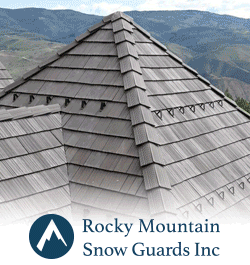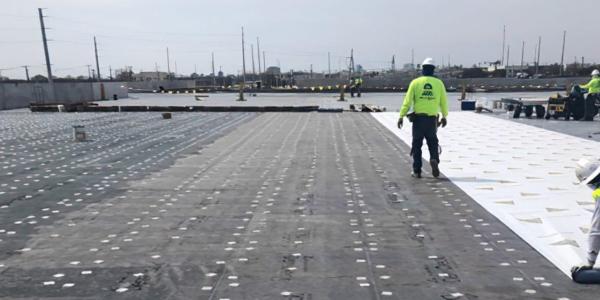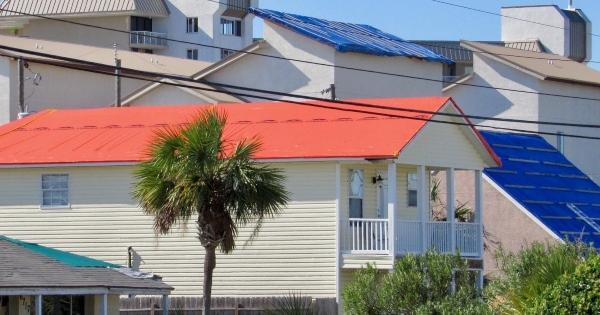Rain or shine, this roofing assembly weathers every storm
February 8, 2024 at 3:00 p.m.By Georgia-Pacific Building Products.
With the right material and extra precautions, a data center stands up to extreme weather in the heart of Texas’ Hail Alley.
When a Texas construction company set out to install a roof on an important data center in America’s Hail Alley, it was the wettest spring on record. The Dallas-area crew faced torrential rains, golf ball-sized hail and wind gusts over 60 miles per hour. They knew that data centers require additional performance measures to ensure the safety of the equipment inside, but the weather was working against them. Nevertheless, when the owners pushed to get the buildings up and operational as quickly as possible, the company rose to the occasion, keeping in mind the additional design and material requirements, and ensuring the structure could withstand wind gusts up to 140 miles per hour.
Time is money in data center assembly
The build crew’s workload wasn’t enviable – with epic storms at their backs, the team needed to outsmart the weather, not be held captive by it.
With decades of experience in the construction of such buildings in all sorts of conditions, Rick Chappell, strategic account specialist for Sika Sarnafil Roofing Systems, knew this project would take skillful planning. He also understood the necessity of having a temporary roof assembly to take wind and rain out of the scheduling equation.
The plan was to install a portion of the assembly using materials that could act as a temporary roof. With many different trades coming up to the roof to complete installation, the roofing contractor would need to provide wind-uplift resistance to withstand impending storms and build in durability to protect against foot traffic.
Temporary shouldn’t mean flimsy
Data center construction calls for unique capabilities that go above and beyond typical commercial construction requirements. So, the architecture firm built extra redundancies into the assembly design.
“With a data center roofing assembly, we look at redundancy more than anything,” says Chappell. “One drop of a water leaking into the data center will destroy everything.”
After working with DensDeck® Prime Roof Board on previous jobs, the architect quickly made it his go-to solution for both a thermal barrier and a cover board.
Chappell, a twenty-plus-year veteran of the roofing industry, has observed the dependability of gypsum roof boards for roofing assembly designs. Not only does the thermal barrier provide a good surface for the installed roofing system, he explains, but it also enhances the high wind uplift resistance.
“Having the ability to attach the thermal barrier to the steel decking and to apply the vapor retarder over the thermal barrier will allow the interior building construction to continue. You’re not waiting on the different phases of the roofing assembly to dry-in the building,” Chappell says. “And the ease and quickness of application is great!”
For the thermal-position in the roofing assembly, roofing contractor Jarrell Perrin and his construction team at Sun Commercial Roofing installed 5/8-inch DensDeck Prime Roof Board to a steel deck with a robust vapor retarder on top. Perrin notes that this provided a good adhesion substrate, bonding easily without requiring fasteners that would come through the roofing assembly.
DensDeck Prime Roof Board made a second appearance in the assembly design, this time with the ½-inch board in the cover board position. The cover board was adhered to two layers of polyisocyanurate insulation (polyiso), as well as Sarnafil feltback membrane, adhered to the cover board.
This dual DensDeck Prime Roof Board configuration made the roofing system a worthy adversary for rain and wind. The EONIC™ Technology in DensDeck Prime Roof Board doubles the board’s resistance to moisture, making it the only roof board to meet the industry’s tough new three- part specification for moisture resistance.
Equally of note, the on-site contractors prefer it, says Perrin. “The guys like DensDeck [Prime Roof Board] because it’s easier to cut in the field and it’s lighter to handle. So, they can move the material around site a lot easier,” he explains. “They would choose the DensDeck [Prime Roof Board] for those two reasons. We really enjoy working with it in the field over other products. And if the guys like working with it, it makes everybody’s life a lot easier!”
Better design that’s built to stand strong
Against time and requirement challenges, teamwork and multitasking were at the heart of a successful strategy for this project. By using DensDeck® Prime Roof Board, along with a robust vapor retarder, team members were able to install the rest of the roof and more quickly dry-in the building. Then the rest of the team could get to work constructing the interior, while the exterior trades finished installing the rest of the roofing components, yielding a solid final construct that could withstand all kinds of wear and tear.
Foot traffic is a major concern with data center construction. With the roof now installed, the team’s attention turned to the various tradespeople who would be treading on the assembly. From welders to steel outfitters to plumbers — anywhere from twenty to thirty people working for up to three weeks — the roofing assembly needed to provide sturdy protection against ongoing foot traffic. Given that the building would house such sensitive materials, the redundancies and extra precautions in using DensDeck Prime Roof Board as a thermal barrier and cover board helped to provide extra protection against any roughness the roof would endure, including the extreme hailstorms that the area is known for.
“Having a hard board, gypsum core, underneath a single-ply membrane provides a high compressive strength needed in defending the thermoplastic membrane against hail impacts, Chappell explains. “Having a cover board gypsum core, the hail impact is minimized.”
“We like DensDeck Prime [Roof Board] because of the extra protection it gives,” adds Perrin. “DensDeck [Prime Roof Board] adds to the long-term stability of the roof: the hail resistance and extra puncture resistance long-term.”
Trusted performance saves the roof… and the day
We take extra precautions to protect the things we value most. For the build team, that meant taking weather concerns into account not only for construction, but also for the life of the roof, when strong, long-term protection would be necessary to keep millions of dollars’ worth of equipment safe from the outside.
It also meant that DensDeck® Prime Roof Board would be the key component in constructing the roofing assembly. With its flexural strength and long-term resistance to moisture and impact damage from the outsie, DensDeck Prime Roof Board would give the team confidence to put their name to their work.
“We would always recommend DensDeck [Prime Roof Board]. Not having it, you’re sacrificing durability and long-term potential life of the roof,” notes Perrin. “Our ideas and name are on the line more than anything. We just want to be synonymous with a good product. So, we need something that’s provable, skilled, and long-term.”
For this data center’s experienced team, DensDeck Prime Roof Board was the time-tested and trusted product of choice for reliable construction. Its performance was instrumental in ensuring the project finished strong at every turn of the construction process.
“I’ve seen the growth and innovation of cover boards over the last 20 years,” says Chappell. “For me, using cover boards and thermal barrier boards are an integral part of creating a roofing assembly. Cover boards helps to increase the wind-uplift values of a roof assembly by providing a strong, high-performing layer of protection.”
As more storms pass through and time goes on, this Dallas data center will stand strong, protecting business’s most valued data assets — deep in the heart of Texas.
Original article source: Georgia-Pacific Building Products
Learn more about Georgia-Pacific Building Products in their Coffee Shop directory or visit DensDeck.com.





-2025-xtv-mls-tour-2.png)


















Comments
Leave a Reply
Have an account? Login to leave a comment!
Sign In